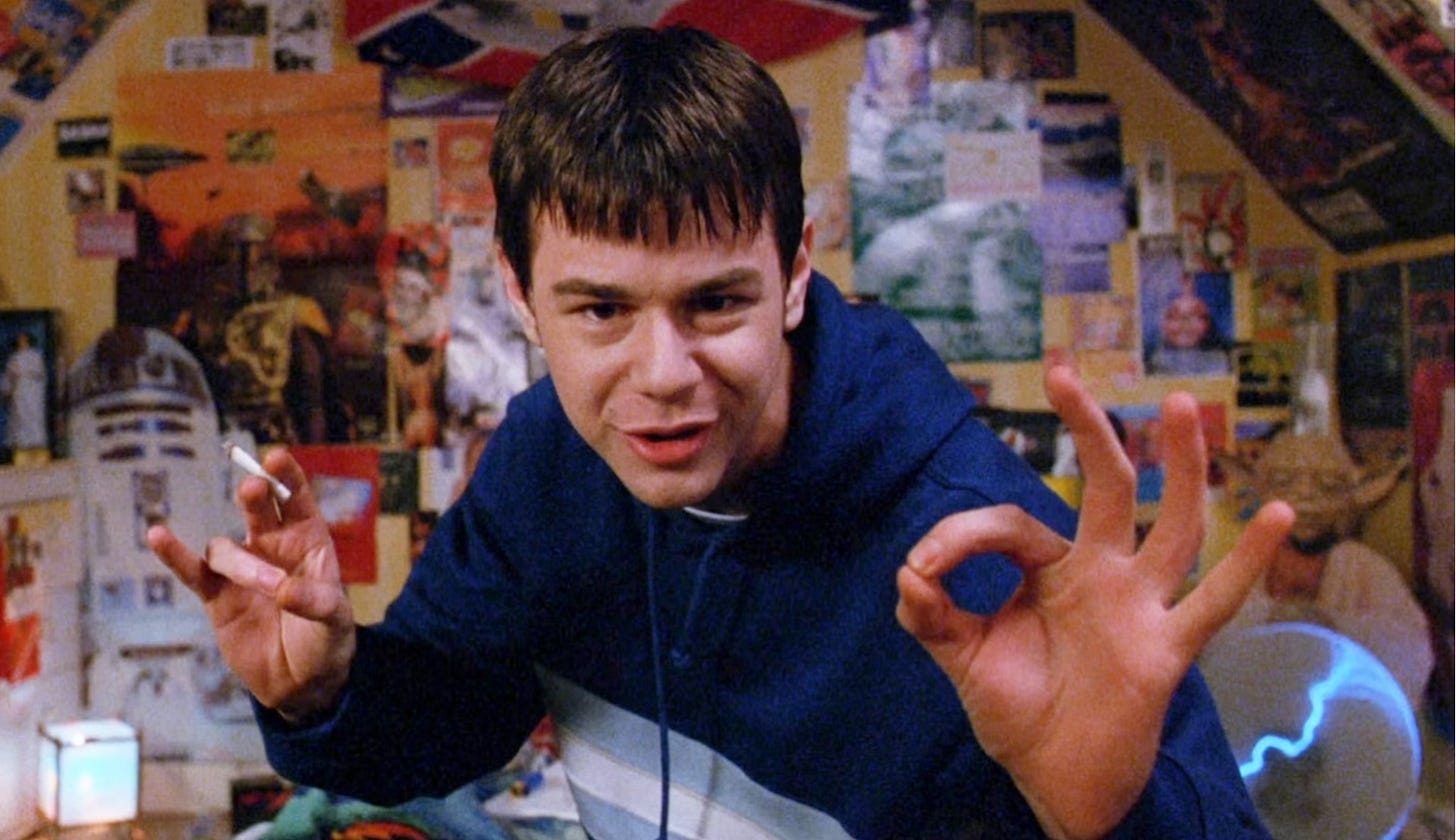Wellness is shifting.
Attention is turning from chronos and measured time, where wellness is about optimising, producing, and perfecting, towards kairos and felt time, where wellness invites more of a loosening, untying, and untethering.
Danny Dyer leading meditation on ITVs The Assembly feels like a cultural inflection point (watch here).
To me, Danny Dyer will always be Moff. He is rave culture shouting, "Nice one bruva!” in Justin Kerrigan’s film Human Traffic (1999). But Dyer as a meditation teacher? To be fair, there is an entire scene devoted to the shared ontologies between Zen and the Jedi in the film.
“The Emperor wants to control outer space. Yoda wants to explore inner space. That’s the fundamental difference between the good and the bad sides of the Force…” - Moff
The scene offers a potent ontological contrast between a way of being that imposes order on time (chronos), and a way of being that enters into time as flow (kairos). One seeks to dominate; the other, to learn.
Star Wars has long been described as a “secularised American religion,” its themes offering up a moral framework for those seeking the sacred outside organised religion. In the 2001 UK Census, 390,127 people, 0.7% of the population, identified as Jedi. The Jedi philosophy continues to resonate with the ‘spiritual but not religious’, now the fastest-growing demographic: 53% in the UK and 28% in the US.
And so, back to Dyer.
Watching him lead a guided mindfulness practice on ITVs The Assembly was pure joy. Like the Jedi, less space monks, more space samurai, Dyer begins with the chattering mind. The Pali term papañcha, often translated as ‘mental or conceptual proliferation’, is useful here: the endless inner commentary of planning, regretting, doubting, and worrying.
As Dyer says,
“So I realised that my brain talks to me a lot… and it also tells me how shit I am…And I can still hear my voices in my head going, ‘You were shit today,’ or ‘You done that,’ or ‘You look fat.’”
It is beyond moving to see him speak with such vulnerability. He quite rightly points out that the world we live in is a big part of why we are feeling this way. We simply cannot meditate our way out of the chaos we are being forced to endure.
He is a great teacher. He creates the container. He continually invites them back into the practice with his guidance. He is energetically holding space for them. It is deeply touching. What emerges is not a technique or a display of mastery, but an experience of collective presence.
In a media landscape saturated with elite biohacking and mindfulness-as-performance, this instance captures an unscripted break in the discourse of wellness. This was not Deepak Chopra opening the Park Stage at Glastonbury. This was Danny Dyer, Moff, guiding a group of autistic, neurodivergent, and learning disabled interviewers to let go of the chattering mind and arrive with intention into the present moment. It was raw, real, and relevant.
Wellness moves between two distinct registers.
One is focused, disciplined, and oriented towards performance. It involves counting, measuring, goal-setting, and repetition. In yogic terms, this is dharana, the act of bringing one’s attention back, again and again, to a single point of focus. We need this skill to guard against distraction.
The other is softer, more expansive. It is the wellness of surrender, of opening, of letting go. In yogic terms, this is dhyana, opening to the whole. We know it instinctively. It is what happens at gigs, festivals, in singing and dancing, in playing and sport, a good belly laugh, and losing oneself in the moment. It’s not about relaxation or pleasure, though those may follow, but about experiencing the whole.
Iain McGilchrist’s hemisphere hypothesis helps illuminate this distinction at the neurological level. Both hemispheres of the brain are involved in perception and meaning-making, but they differ in orientation and relational stance. It is the howness of their engagement that matters most.
The left hemisphere is goal directed. It reduces complexity to function, seeks efficiency, and pursues control. It is this hemisphere that supports dharana, bringing attention back to the same point of focus. As Dyer says, counting can help, coming back to the breath, relaxing the forehead, the face.
The right hemisphere by contrast, sees the whole. It relates rather than grasps. It intuits the field. It is this hemisphere that supports dhyana, opening to the whole. In meditation, it is how we experience everyone in the room, not by sight, but by presence. Even with eyes closed, we know others are arriving into the present moment as well.
This is the distinction between chronos, the measured time of clocks, and kairos, the lived experience of time’s fullness. Quantity and quality. When the present moment deepens, stretches, and suspends as it does with meditation, it is best described by Henri Bergson’s concept of la durée.
Bergson calls durée a “highly dynamic form of temporal experience” (Dainton, 2024): fluid, immeasurable, and unquantifiable. “Any attempt to conceptualize the flux of consciousness could succeed only at the cost of distorting the phenomena” (ibid).
Durée cannot be captured, only entered. Like in apophatic theology, where the Divine is described by what it is not, Bergson argues that la durée cannot be understood through concepts and ideas. Instead, it must be experienced directly. It is akin to the kind of direct insight found in nondual traditions, such as the sudden clarity of kenshō or satori.
The shift from chronos to kairos in wellness is unmistakable.
As we untether from our devices and relinquish the urge to measure, we begin to surrender to a more sensory world where time is sacred, shaped by rituals of ablution, by formation through discomfort, by the honouring of lunar rhythms over linear ones, and even by the healing truth of solvitur ambulando: it is solved by walking.
"How Make-Up Became A Powerful Tool In My Mental-Health Journey" - Vogue
“How a mindful coffee ritual became my anchor for slow living” -Irrational Adventurer
“Young people turn to fishing for its anxiety-busting effects” - The Times
“Hot Girl Walk is trending – here's all the benefits” - Stylist
“What Is A Women's Circle (And Should You Join One)?” - Vogue
“What Is 'Bed Rotting'? Gen Z's Newest Self-Care Trend, Explained” - Health.com
“TikTok’s new favourite self-care trend? The four-hour ‘Everything Shower’” - The Guardian
I read these trends in untethering as a direct response to technology’s broken promise of efficiency. The shortcomings of ‘slow movements’ are well documented, but these trends do suggest the opening up a “political space for questioning our obsession with speed as a virtue in and of itself,” (Wajcman: 175, 2015).
Philosophers once believed that technological innovation would grant us the time needed to enter into beauty, reflection, and being. Instead, the attention economy has left us in a state of constant stimulation, dopamine deficit, and burnout. The absence of the quotidian mundane has not deepened moral engagement. If anything, it has intensified the very conditions once associated with boredom’s ethical potential. Boredom hasn’t been resolved, it’s been displaced. In its place, we find saturated attention: fragmented, commodified, exhausted. The result is a new kind of moral detachment. A moral anaesthesia.
Option paralysis.
The idle time we once spent heating food on the stove or walking to the shop, rather than clicking a button, was never truly idle. It was durée. When I think of going to the shop, I don’t recall a checklist of steps. I remember the texture of it: getting dressed, walking, browsing, noticing what else I might need, choosing how to pay, carrying it home, perhaps bumping into someone on the way. Many things happen when I ‘go to the shop.’ When I buy online, none of that happens. The payment is already saved. The moment is already over.
However, even these promises of efficiency have unravelled. What was once effortless - clicking, buying, forgetting - has become saturated and stalled. Now, a simple search floods me with options. Ease has collapsed into excess. Douglas Coupland called this option paralysis in Generation X: Tales for an Accelerated Culture, “the tendency, when given unlimited choices, to make none” (1991).
We no longer withdraw from meaning due to emptiness, but because of excess. There is too much to see, too much to do, breeding indifference, complicity, and moral fatigue. We are simply too burnt out to care. Conditions ripe for totalitarianism.
Tucked into Glastonbury’s Shangri-La in 2024 was the Resistance Gallery which featured some of Amelia Troubridge’s Beautiful Protest series. It reminded me of when I first moved to the UK. Street parties and protests were firm fixtures in my calendar and because I didn’t yet live in London, it involved: sorting trains, staying with friends, and booking tickets for a night out. It was more than a social occasion, it was a reason to gather around a shared set of moral commitments, a celebration of solidarity, resistance, and collective joy. It was kairos intertwined with moral clarity and play.
Throughout the 1990s and early 2000s, the streets of London held space for something rare: gatherings that were equal parts joyful, political, and unpredictable. Then came the 1994 Criminal Justice and Public Order Act, restricting unlicensed raves and protest parties. Followed by heavy police tactics such as kettling in 2000. After 11 September 2001, the War on Terror shifted the tone and gatherings were seen as potential security threats. As time went on, grassroots events were either cancelled, regulated out of existence, or absorbed into more corporate formats.
And then came 2007, the year the first Apple iPhone was launched, and with it, a powerful redirection of attention. As the streets emptied out, our hands filled with weapons of mass distraction. The impulse to gather didn’t vanish, it was rerouted, pixel by pixel, into curated, atomised, and siloed selves.
Since then, the only place I still experience that union of durée, kairos, and moral regard is at the Glastonbury Festival. I’ve taught meditation in the Healing Fields since 2010. Each year, the ritual and the rhythm reawaken my sense of the collective. My moral compass is recalibrated. My sense of play renewed. Time dissolves.
It is kairos over chronos: the wellness of untethering.
Until the next dispatch,
Tina
Coupland, Douglas. (1991). Generation X: tales for an accelerated culture. New York: St. Martin's Press.
Dainton, Barry, "Temporal Consciousness", The Stanford Encyclopedia of Philosophy (Stanford Encyclopedia of Philosophy, Temporal Consciousness). (Fall 2024 Edition), Edward N. Zalta & Uri Nodelman (eds.)
Wajcman, Judy. (2015) Pressed for Time: The Acceleration of Life in Digital Capitalism. Chicago: University of Chicago Press.





